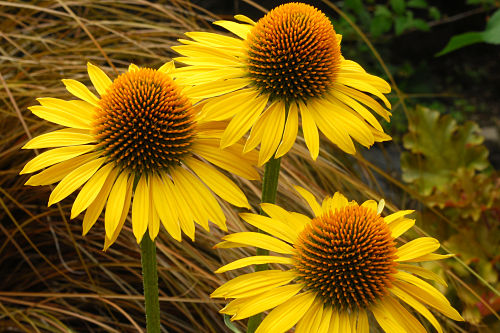Striking gold
/Echinacea ‘Maui Sunshine,’ as gold as it gets. — Terra Nova Nurseries
In the psychology of color, golden hues suggest elegance, sophistication and abundance, adding richness and warmth to anything near. That’s not a bad way to think of gold as an element of the garden palette.
Gold is yellow taken to its ultimate intensity, a deeply saturated version burnished with glints of the even more fiery part of the spectrum. This is not the demure yellow of spring seen in the butter-pat colors of daffodils and the clear, pale hues of common primroses. There, the more soft-spoken yellows are all of a piece with spring’s pastel color scheme of pinks, whites and lavenders.
Come summer, stronger sun calls for bolder, brighter colors that won’t fade away to a pallid cream or white. Gold can take the heat. Like orange and red, its partners on the color wheel, gold doesn’t whisper – it shouts and its impact carries over a distance.
In the garden and in art, experts often divide the spectrum into “warm” and “cool” colors, which we perceive in different ways.
“Red, orange and yellows are the warm colors because they evoke the images of the fireplace, golden summer days and molten sunsets,” says Sydney Eddison in his insightful book “The Gardener’s Palette” (Contemporary Books). “Warm color advances toward you, just as heat does, but cool colors withdraw.”
This idea should prompt you to position your garden gold at toward the front of a border, with cooler blues, purples and foliage greens behind it. To do otherwise would draw the eye to the back of your composition at the expense of overlooking the foreground plantings.
One idea for combining garden colors calls for concentrating on related hues, those adjacent to one another on the color wheel. With warm colors – all equally loud – this can be a little overwhelming. You can assemble a collection of gold, orange and scarlet flowers since there are many candidates among the annuals alone – marigolds, salvias, petunias and verbenas to name four.
Unless you’re addicted to over-stimulation, this go-for-broke color scheme is best used in small doses. It could succeed on a patio or in a small, enclosed entry garden. Truthfully, pairing golden flowers or foliage with cooler complementary colors offers shine without glare. Even the sun is set in a sky of calming blue.
Hakonochloa ‘All Gold,’ an ornamental grass. — Terra Nova Nurseries
Second only to ubiquitous green, the yellow shades in flower and leaf result from the commonest pigments in the plant kingdom.
“As the most abundant flower color, it is easy to end up with a vast number of different yellows that sit uneasily together,” says Sue Fisher, author of “Garden Colour” (Hamlyn Press). Her advice? “Try to limit the number of shades.”
I’ve always thought it important to parse out the yellows and the golds, since the pure yellows and the brassier golds are not always compatible. I can offer no better example than the serene paleness of ‘Moonbeam’ coreopsis and the bawdy, up-front gold of ‘Early Sunrise,’ another hybrid of the same species. The first is an excellent filler that plays well with others; the second needs a strong companion.
This may be the key point to remember in working with gold: It needs to be paired with colors of equal intensity. Pale blues, soft violets, apricots and pinks really won’t cut it.
On the “cool” side, give it vibrant, deep purples and blues . My ‘Early Sunrise’ sings among clumps of the annual salvia ‘Victoria’ and ‘Hidcote’ lavender; my ‘Fireworks’ goldenrods look great with ‘Purple Dome’ asters. On the “warm” side, pair gold with the dark red found in plumy astilbes like ‘Red Sentinel,’ the brick red of sedum ‘Autumn Joy’ or the burnt orange of helenium ‘Mahogany.’ The foil could also be foliage, as in burgundy, black or dark green leaves.
Gold can be used to cast a pool of sunshine into shady areas, too. Ligularia with its stiff flower stalks and golden versions of graceful hankone grass are two subjects that enjoy shade. Certain deciduous winterberry hollies could offer an end-of-the-year surprise in sheltered locations when leaves drop to reveal a profusion of golden berries.
If pure gold strikes you as too much of a good thing, consider the many gold-and-green variegated foliage plants. ‘Color Guard’ yucca, ‘Spotted Tiger’ yellow flag iris or gold-spangled zebra grass, a form of miscanthus, are a few suggestions. Gold variegated hostas, coleus and sedges offer still more compelling choices.
Some gardeners shy away from strong color, pining after British-style gardens of pastel flowers that suit the cloudy, misty, cooler climate of England. Here, where the summers are hot and sun is frequently overbearing, you need a dose of color with punch and attitude. Treat yourself to some glitter and sparkle – go for the gold.
* Terra Nova Nurseries, source of plants shown, is a wholesale grower. To final retail and mail order suppliers, go to terranovanurseries.com and click on “Ordering” or call (800) 215-9450.


